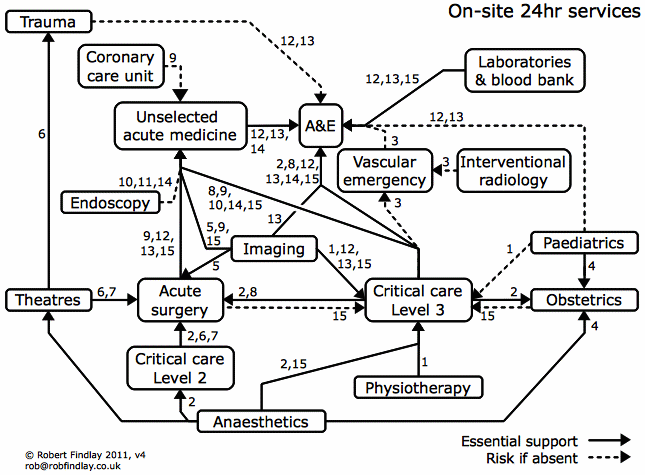Hospitals accepting unselected medical emergencies must have on-site surgery.
Acute health care services: Report of a Working Party.
Academy of Medical Royal Colleges, September 2007, p.22
There’s a lot of guidance like this, from the Royal Colleges, subspecialist societies, NCEPOD, and the Department of Health, all describing in helpful detail the critical links that exist between different acute services.
But each document describes only a few strands in a complex web of interdependencies. Senior clinicians and managers, however, need a system-wide view, but it is difficult to piece together the whole picture from this mass of detail.
The lack of a big picture can waste a lot of time. When acute reconfigurations are being considered, managers and clinicians may get together in a large group to draw up the reconfiguration options. Much later, after a lot of work, some options have to be struck out when a fatal flaw is discovered (such as not being able to separate paediatrics from obstetrics). At worst the lack of a big picture can be dangerous, when piecemeal changes are made locally, to individual services, without realising that they could destabilise the whole hospital.
So we need an overview of these important clinical linkages. Looking only at those 24-hour services that must be provided on the same hospital site, we think the links look something like this. A solid line means that one service must support the service it points to; a dotted line means that it is possible to run the service without that support but procedures must be in place to ensure safety.

Clinical linkages: the numbers are references to guidance documents
There are caveats of course. It isn’t possible to capture all the nuances of this complex guidance in one diagram: for instance, the distinction between a selected and unselected acute medical take is not fully captured. Also there are cases where older guidance states a requirement that is not mentioned in more recent, overlapping guidance; this leaves it unclear whether the requirement has been softened. In the full version of this work, therefore, the diagram is accompanied by the relevant passages from the guidance (referenced by the numbers beside the arrows).
We think this is the first time that acute clinical linkages have been comprehensively published in this way. At a time when acute hospitals and commissioners are under pressure from the EWTD and the financial squeeze, many are considering whether they could transfer services to an adjacent hospital or stop providing them altogether. This map of acute interdependencies should help to show where this can, and cannot, be done safely.
To take just one example, could you save money by downgrading physiotherapy to daytime only? A novice manager might think so. But the answer is clearly no, because that would put at risk the intensive care unit, acute surgery and medicine, and the A&E department. Not a career-enhancing move.
